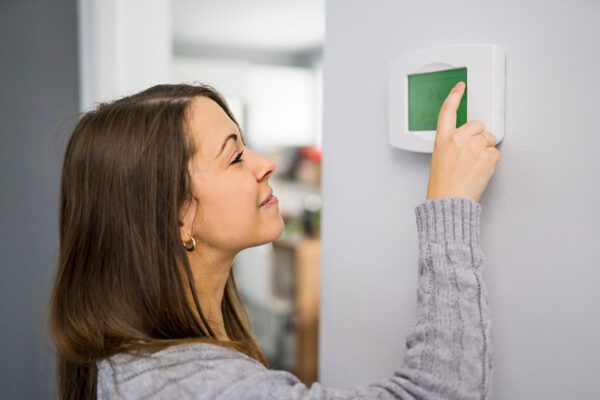
Replacing Your Thermostat
This is not the time of year in Macon, Georgia, for the air conditioning to quit! Summer is in full swing, after all. If your HVAC system is already not cooling as it should, and you’ve checked the air filter, you’ve had the HVAC professional inspect, and they tell you it needs a thermostat replacement. But what type of thermostat should you look for?
Seriously? If that is all it will take to cool off again, how do you test a thermostat so that you don’t have to pay for that service again? Here are the steps you need to test your thermostat next time you’re having an issue with either cooling or heating your home:
- Step One: Turn the power off and remove the thermostat cover so the wires are exposed. Typically, the wires are screwed to terminals marked R for red, W for white, G for green, Y for yellow, and C for common. Your thermostat may only have a Red/White or Red/Green setup. You can find videos online to help identify the wires. We recommend taking a picture with your phone for reference.
- Step Two: Remove the wires by unscrewing them from their terminals, making sure they don’t fall into the hole. Professionals often wrap them around a pencil to keep that from happening. The red and white wires are standard for power and heat.
- Step Three: Twist the wire’s bare ends together and keep them from touching any of the other wires or each other. That could short-circuit the entire system, and you’ll need more than a thermostat replacement.
- Step Four: Turn the power back on, and if the blower comes on and the heater furnace ignites, then the problem was an improperly connected thermostat. Or the thermostat is defective, and you need a thermostat replacement.
- Step Five: If the furnace burner didn’t ignite, it may be the wire continuity from the thermostat to the furnace may have a broken wire. Look for an online video on how to check this with a multimeter.
Can thermostat wires shock you?
If they do, the thermostat is wired up wrong! No, thermostat wiring will not shock you; the voltage is too low to cause any shocks or other serious injuries. Call the experts at Total Comfort to assist you with the next steps!
Will a thermostat work with dead batteries?
No, and that should be the first thing you check before calling for a professional HVAC visit. The problem can be that simple – replace the thermostat batteries and change the air filter, and your AC could be working just the way it should be.
How do thermostats break?
A thermostat is like anything else in your home, they age, and over time, they quit working. A typical issue that causes a thermostat to break is the wiring inside the thermostat or in the wall between the thermostat and HVAC system has come loose or has gotten old. If you have critters getting into your house, like mice, rats, squirrels, opossums, etc., they may have chewed the wiring.
Take the cover off the thermostat, and if the wire appears to be in place and in good condition, try installing a thermostat replacement. If that didn’t fix the issue, and you’ve changed the air filter, you’ll need to call an HVAC professional to inspect the system.
Will any thermostat work with my HVAC system?
Most residential HVAC systems are low-voltage, and any type of thermostat replacement will work. With a high-voltage HVAC system, you need to refer to the manufacturer’s manual or website for recommendations to get the right thermostat replacement for your system.
What should I do when a thermostat stops working?
There could be several reasons why a thermostat is not working. When a thermostat quits working, it could be the batteries are dead or it could be there isn’t any power getting to the unit. This could be from broken wires as we discussed earlier, causing a poor connection to the HVAC system. Or it may be a tripped circuit breaker or a blown fuse.
First, change the batteries. If that doesn’t get the thermostat working again, check the fuse box or circuit breaker. If those are all in good order, remove the cover again and with a small paint brush or canned air, blow or brush off any dust. If you still get the unit to work, get a thermostat replacement, and if that doesn’t do it, you’ll need to call for professional HVAC help.
How does a thermostat work?
Do you know how a thermostat works? There are two different types of thermostats: Electronic and Electromechanical. Electromechanical is the old school thermostat and is more detailed in how it works. The basics of this thermostat contain a bi-metal coil or a metal strip that moves when there is a change in the temperature. This causes a small mercury-filled vial to tip in one direction or the other, depending on cold or hot. As the mercury moves in the vial, it signals the HVAC to cool or heat.
If this is the type of thermostat that you have now, you need a thermostat replacement! These are old school and with an upgrade to the electronic thermostat. It will with your energy bills and keep your home more consistently comfortable! Contact us today for more information and let us at Total Comfort assist you with making the best decision for your needs.
The electronic thermostat is easier to understand how they work. They are basically small computers that use sensors to determine the right temperature. They have features that are beneficial by lowering your energy bill with programmable settings. You can program them to turn the AC up high when you’re not home and have it turn the temperature setting down an hour before you get home. Then you can walk into a nice cool home!




